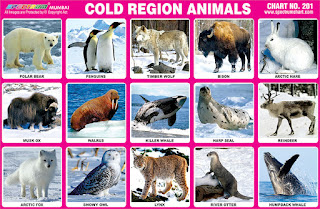Polar Bear - Polar bear is
a carnivorous bear whose native range lies largely within the Arctic
Circle. It has black skin under the white fur. The fur keeps them
very warm. They are strong and can swim very well. Polar bears are
similar in size to a normal bear but have a slimmer neck, longer
legs and fur. They are mostly carnivorous & mostly eat seals and
fish.
Penguins - Penguins are
sea-birds in the family Spheniscidae. All penguins have a white
belly and a dark (mostly black) back. Penguins cannot fly, but they
can swim very well. Penguins live only in the Southern Hemisphere of
the world: Antarctica, New Zealand, southern Australia, South Africa
and South America.
Timber Wolf - Timber wolf
is a canid native to the wilderness and remote areas of Eurasia and
North America. Its winter fur is long and bushy and predominantly a
mottled gray in colour.
Bison - Bison are massive
animals, characterised by their long, shaggy brown coats, have poor
eyesight but acute hearing and an excellent sense of smell. Bison
are herbivores and eat simple foods. Their main foodstuff is grass
and sedges. Their lifespan is 15 – 20 years.
Arctic Hare - Arctic hare
is a social animal that lives in the frigid tundra of North America,
Newfoundland and Greenland. Arctic hare survives with a thick coat
of fur and usually digs holes in the ground or under snow to keep
warm and sleep. Arctic hares look like rabbits but have shorter
ears, are taller when standing, and, unlike rabbits, can thrive in
extreme cold.
Musk Ox - Musk Ox is a
large Arctic mammal of the Bovidae family, noted for its thick coat
and for the strong odour emitted during the seasonal rut by males,
from which its name derives. Muskoxen primarily live in the Canadian
Arctic and Greenland. Muskoxen are herbivores which graze on
grasses, leaves and some Arctic flowers. They are ruminants they
swallow their food without chewing it. Later, they regurgitate the
food and chew it.
Walrus - A walrus is a
marine mammal, the only species of the family Odobenidae. They live
in the cold northern seas around North America & Europe. The
most famous thing about walruses are their tusks. Even though they
are called tusks, they are actually teeth growing out of their
mouth. Walruses can change colour depending on how warm they are.
They are usually different kinds of brown, but as they get warmer,
their skin can turn pink.
Killer Whale - Killer
Whales are cetaceans. They are the largest dolphins in the world,
called 'whales' because of their size. Orcas have mostly black skin
with white patches.They are found in all the world's oceans, from
the cold of the Arctic to the tropical seas.
Harp Seal - Harp seal is a
species of ear less seal. They live in the northernmost Atlantic
Ocean and parts of the Arctic Ocean. Harp seal has a black face with
silvery-gray body. Its eyes are pure black. It has black harp or
wishbone-shaped markings on the back.
Reindeer – Reindeer also
known as caribou in North America is a species of deer native to
Arctic, Subarctic, tundra, boreal and mountainous regions of
northern Europe, Siberia and North America. Reindeer is the only
deer that has been domesticated. Reindeer eat mostly grass. In
winter they often eat lichen, moss and fungi. They are herd animals
and live in groups.
Arctic Fox – Arctic Fox
is a small fox which lives in the Arctic. The fox is about 10-12
inches high (25–30 cm) and it weighs from 6 to 10 pounds (2.7-4.5
kg). The Arctic fox has a round body shape, short nose and legs, and
short, fluffy ears. It has a deep thick fur which is brown in summer
and white in winter. Arctic foxes live for about 3 to 6 years. They
can live in the cold north even when it is -50°C. Their thick fur
keeps them warm.
Snowy Owl - Snowy owl is a
large, white owl of the typical owl family. Snowy owls are native to
Arctic regions in North America and Eurasia. They are yellow-eyed,
black-beaked white bird. It is one of the largest species of owl and
in North America, is on average the heaviest owl species.
Lynx - Lynx is a member of
the cat family. They have short stubby tails and the long tufts of
black hair on the ear. Lynx are usually solitary animals and will
spend their time both hunting and resting alone. Their lifespan
ranges between 12 - 20 years.
River Otter – River
otters are animals that live near and around water. They live in
nests called holts. They are long and slim animals with four short
legs that can be longer than a meter. They have a thick fur coat
that keeps them warm even in freezing water. They have very soft,
insulated underfur, which is protected by an outer layer of long
guard hairs.
Humpback Whale - Humpback
Whale is a large baleen whale with long flippers and a knobbly head.
They can be found in every ocean. They can grow to 15–16 m (49–52
ft) long and weigh up to 40 metric tons. The male humpback whale is
known to sing for up to 22 hours at a time. Their lifespan ranges
from 45 to 100 years.


No comments:
Post a Comment